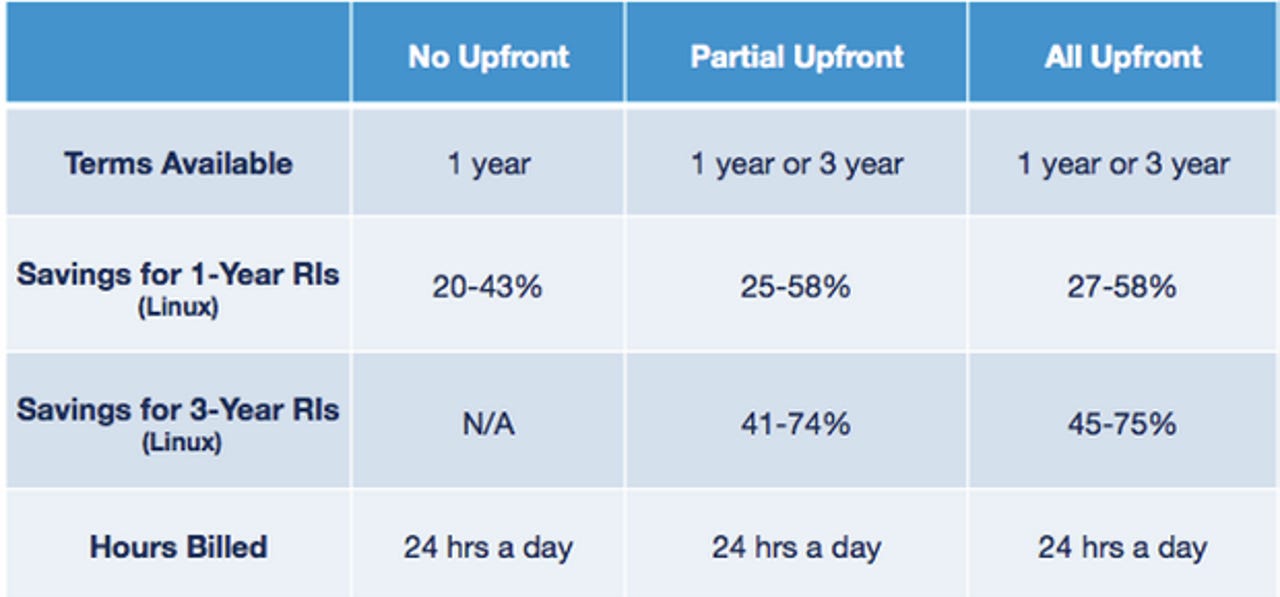Amazon undercuts Google's cloud prices - providing you can pay up front

Amazon has introduced a way to pay for cloud infrastructure that undercuts Google – provided you're willing to shell out up front towards at least one year of use.
Amazon Web Services (AWS) has changed the way it charges for its Reserved Instance (RI) compute infrastructure on its Elastic Compute Cloud (EC2). EC2 customers pay for Reserved Instance infrastructure whether they use it or not, unlike EC2's On Demand Instances.
The charges for Reserved Instances are no longer split into light, medium and heavy usage but instead reflect how much a user is willing to pay up front.
Users can chose to pay no up-front costs, or some or all of the costs up front, and must commit to paying for one or three years of usage. A table produced by the cloud portfolio management company RightScale summarises the available payment options below.

RightScale has compared the cost of using the new RIs with renting infrastructure via Google Compute Engine. It put the cost of RIs against that of Google's Sustained-Use instances, which it said was the closest apples-to-apples comparison.
No up-front cost RIs compare less favourably, with Google working out 11 to 30 percent cheaper depending on the configuration of the virtual machine. RightScale points out, however, that some of the EC2 instances used in the comparison are based on higher-spec hardware, with AWS offering more memory on the high-memory instances and twice the memory on the high-CPU instances, along with an SSD, which it says "balances Google's lower price".
AWS also offers additional volume discounts for RIs, which start at five percent when the annual value of RIs reaches $500,000, and ranges up to 10 percent when the annual value reaches $4m.
Another distinction is that RIs demand a commitment to use them for one year, whereas Google Sustained Use model requires no usage commitment.
It is when customers commit to paying part or all of the costs up front that EC2 instances work out cheaper than Google.
The cost of renting a RI for one-year and paying partial costs up front works out one to 14 percent cheaper than comparable offerings from Google, says RightScale. RIs are up to 38 percent cheaper if a customer commits for three years and pays all costs up front, the comparison claims.
However, RightScale warn customers that there may be significant cuts to charges for on-demand instances during those three years, as well as the introduction of new more powerful instance types.
When comparing the cost of EC2 RIs to other EC2 on-demand instances, the time it takes before the RI begins saving you money depends on the commitment term.
RightScale found it takes 261 days to break even for a one-year, no up-front costs RI; 226 days for a one-year, partial up-front RI; and 222 days for a one-year, all up-front RI. A three-year, partial up-front RI took 435 days to break even, and a three-year, all up-front took 409 days.
AWS has faced increasing competition on price from Google and Microsoft in the cloud infrastructure market. Last month Google pledged to reduce the price of some of its offerings by between 23 and 79 percent.
Read more:
- Google Cloud Platform certified for payment card data amid deal with WePay
- Amazon Web Services wants to run your world
- AWS: With more than 1 million active customers, we're your stack